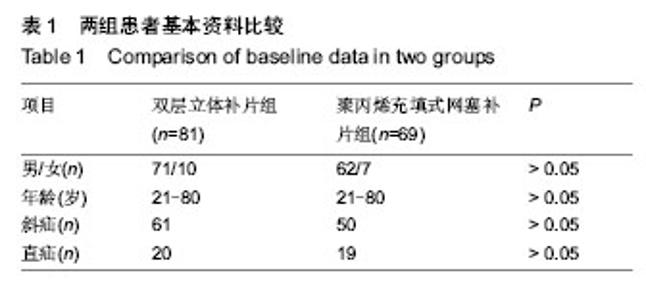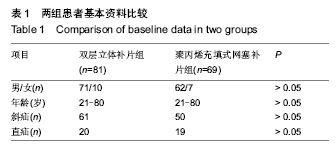| [1] 唐健雄.疝修补术[J].中国实用外科杂志,2001,21(2):66.
[2] Fitzgibbons RJ Jr,Giobbie-Hurder A,Gibbs JO,et al.Watch -ful waiting vs repair of inguinal hernia in minimally symptomatic men: a randomized clinical trial. JAMA.2006;295(3):285-292.
[3] O'Dwyer PJ,Norrie J,Alani A,et al.Observation or operation for patients with an asymptomatic inguinal hernia: a randomized clinical trial.Ann Surg.2006;244(2):167-173.
[4] Scott NW,McCormack K,Graham P,et al.Open mesh ver-sus non-mesh for repair of femoral and inguinal hernia.Cochrane Database Syst Rev.2002;(4):CD 002197 .
[5] van Veen RN,Wijsmuller AR,Vrijland WW,et al.Long-term follow-up of a randomized clinical trial of non-mesh versus mesh repair of primary inguinal hernia. Br J Surg. 2007; 94(4):506-510.
[6] 李文静,姚红,赵雄,等.无张力疝修补术在临床应用中的探讨[J].广西医学,2007,27(9):1410-1411.
[7] 陈双,杨斌.疝修补的新型材料[J].中国微创外科杂志, 2007, 7(12): 1123-1124.
[8] 牛桂芬.生物材料在腹股沟疝修补中的应用[J].中国组织工程研究与临床康复,2008,12(49):9743-9746.
[9] 中华医学会外科学分会疝和腹壁外科学组.成人腹股沟疝诊疗指南[J].中国实用外科杂志,2014,34(6):484-486.
[10] Kraft BM,Kolb H,Kuckuk B,et al.Diagnosis and classification of inguinal hernias.Surg Endosc.2008;17(12):2021-2024 .
[11] Jiang ZP,WangDY,Lai DM,et al.Variations of urinary bladder and the urogenital fatty fascial compartment with different fillingof the bladder are notable factors relevant to hernia repair-relat-ed bladder injury.Am Surg.2013;79(2):167-174.
[12] Sanchez-Manuel FJ,Lozano-Garcia J,Seco-Gil JL. Antibioticprophylaxis for hernia repair.Cochrane Database Syst Rev.2012;2:CD 00376.
[13] Mazaki T,Mado K,Masuda H,et al.Antibiotic prophylaxis for the prevention of surgical site infection after tension-free her -nia repair: a Bayesian and frequentist meta-analysis.J Am Coll Surg.2013;217(5):788-801.
[14] Mazaki T,Mado K,Masuda H,et al.Antibiotic prophylaxis for thepreventionofsurgicalsiteinfectionaftertension-freehernia repair:a Bayesian and frequentist meta-analysis.J Am Coll Surg.2013;217(5):788-801.
[15] Lichtenstein IL,Shulman AG,Amid PK,et al.The tension-free hernioplasty.Am J Surg.1989;157(2):188-193.
[16] Leber GE,Garb JL,Alexander AI,et al.Long-term complications associated with prosthetic repair of incisional hernias.Arch Surg.2008;133(4):378-382.
[17] 牛桂芬.生物材料在腹股沟疝修补中的应用[J].中国组织工程研究与临床康复,2008,12(49):9743-9746.
[18] 邹云东.补片材料修补腹股沟疝的生物相容性[J].中国组织工程研究与临床康复,2008,12(19):3705-3708.
[19] 韩加刚,王振军,马颂章,等.生物材料在修补复杂性腹壁缺损中的使用[J].临床外科学,2009,17(3):166-169.
[20] 马颂章.腹股沟疝修补术的现状与展望[J].外科理论与实践, 2005, 10(2):109-110,200.
[21] Candage R,Jones K,Luchette FA,et al.Useof humanacellular dermal matrixfor herniarepair: friend or foe? Surgery. 2008; 144: 703-711.
[22] Kolker AR,Brown DJ,RedstoneJS,et al.Multilayer reconstruction of abdominal wall defects with acellular dermal allograft (AlloDerm) and component separation. Ann Plast Surg. 2005;55(1):36-41.
[23] 赵渝,王刚.腹股沟症修补术后慢性疼痛的原因及治疗[J].中国实用外科杂志,2006,26(11):826-827.
[24] Honigmann P,Fischer H,Kurmann A,et al.Investigating the effect of intra-operative infiltration with local anaesthesia on the development of chronic postoperative pain after inguinal hernia repair. A randomized placebo controlled triple blinded and group sequential study design [NCT00484731]. BMC Surg.2007;7:22.
[25] 陈杰.实用疝外科手术技巧[M].北京:北京科学技术出版社,2008: 20-40.
[26] Rutkow IM,Robbins AM.Mesh-plug hernia repair, a follow-up report.Surgery.1995;117(5):597-599.
[27] 肖晖,关山,崔志刚.疝环充填式无张力疝修补术在老年腹股沟疝中的应用[J].中国实用外科杂志,2001,21(2):82-83.
[28] 沙金辉.无张力疝修补术中补片类型的选择[J].中国社区医师, 2006,8(21):45-46.
[29] Rutledge RH.The cooper ligament repair.Surg Clin North Am.1993;73(3):471-485.
[30] Bernardino S.ACL prosthesis: any promise for the future? Knee Surg Sports Traumatol Arthrosc. 2010;18(6):797-804.
[31] 糜英华,刘英,王相.聚丙烯修补材料在腹股沟疝治疗中的应用[J].中国组织工程研究与临床康复,2010,14(16):2995-2998.
[32] Brown CN,Finch JG.Which mesh for hernia repair:Ann R Coll Surg Engl.2010;92:272-278.
[33] Alfieri S,Amid PK,Campanelli G,et al.International guidelines for prevention and management of post-operative chronic pain following inguinal hernia surgery. Hernia. 2011;15(3): 239-249.
[34] Kehlet H,Roumen RM,Reinpold W,et al.Invited commentary:Persistent pain after inguinal hernia repair: what do we know and what do we need to know? Hernia.2013;17(3):293-297.
[35] Bischoff JM,Enghuns C,Werner MU.Long-term follow-up af-ter mesh removal and selective neurectomy for persistent ingui -nal postherniorraphy pain. Hernia.2013;17(3):339-345.
[36] Campanelli G,Bertocchi V,Cavalli M,et al.Surgical treatment of chronic pain after inguinal hernia repair. Hernia. 2013;17(3): 347-353.
[37] Paajanen H,Scheinin T,Vironen J.Commentary: Nationwide analysis of complications related to inguinal hernia surgery in Finland: a5 year register study of 55, 000 operations.Am J Surg. 2010;199(6):746-751.
[38] Feng B,He ZR,Li JW,et al.Feasibility of incre -mental laparoscopic inguinal hernia repair development in Chi-na: an 11 -year experience.J Am Coll Surg.2013;216(2):258-265.
[39] 张云,陈鑫,李健文,等.腹腔镜腹股沟疝修补术2056例报告[J].中国实用外科杂志,2012,32(6):28-32.
[40] Pascual G,Rodriguez M,Gomez-gil V,et al. Earlytissueincorporation and collagen deposition inlightweight polypropylenemeshes: bio-assay inan experimental model of ventral hernia. Surgery. 2008;144: 427-435. |



